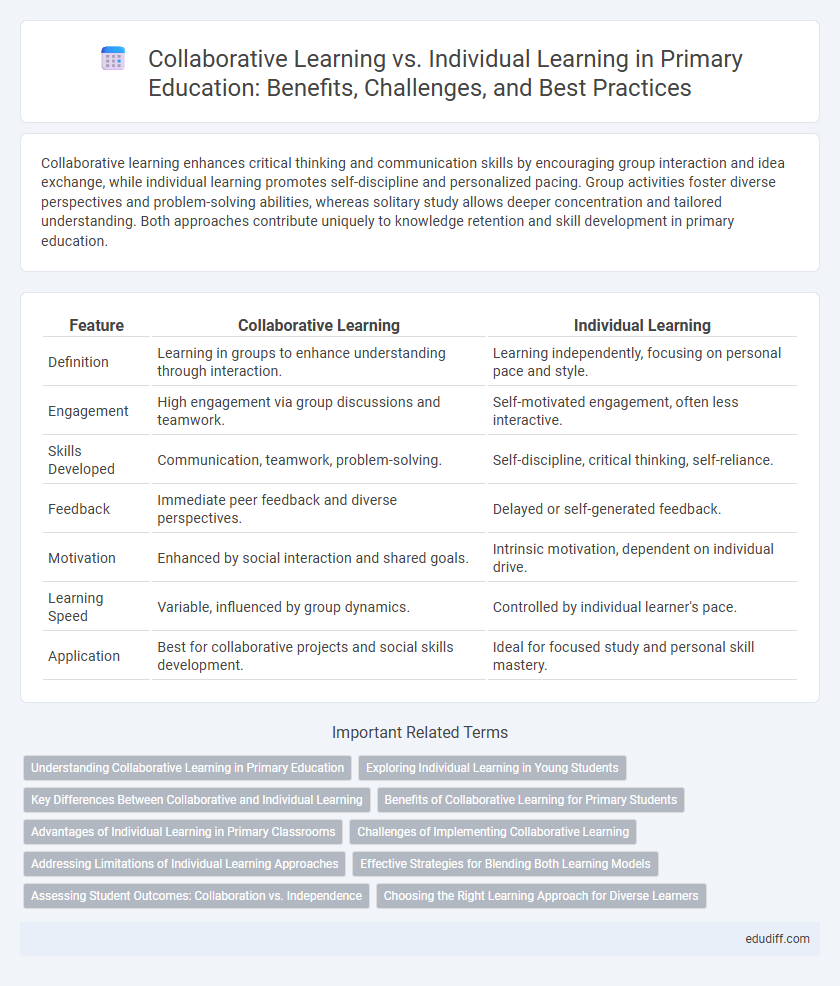Collaborative learning enhances critical thinking and communication skills by encouraging group interaction and idea exchange, while individual learning promotes self-discipline and personalized pacing. Group activities foster diverse perspectives and problem-solving abilities, whereas solitary study allows deeper concentration and tailored understanding. Both approaches contribute uniquely to knowledge retention and skill development in primary education.
Table of Comparison
| Feature | Collaborative Learning | Individual Learning |
|---|---|---|
| Definition | Learning in groups to enhance understanding through interaction. | Learning independently, focusing on personal pace and style. |
| Engagement | High engagement via group discussions and teamwork. | Self-motivated engagement, often less interactive. |
| Skills Developed | Communication, teamwork, problem-solving. | Self-discipline, critical thinking, self-reliance. |
| Feedback | Immediate peer feedback and diverse perspectives. | Delayed or self-generated feedback. |
| Motivation | Enhanced by social interaction and shared goals. | Intrinsic motivation, dependent on individual drive. |
| Learning Speed | Variable, influenced by group dynamics. | Controlled by individual learner's pace. |
| Application | Best for collaborative projects and social skills development. | Ideal for focused study and personal skill mastery. |
Understanding Collaborative Learning in Primary Education
Collaborative learning in primary education promotes active student engagement through group activities that enhance communication, critical thinking, and social skills. It facilitates deeper understanding by encouraging shared problem-solving and diverse perspectives, which are essential for holistic cognitive development. Research indicates that primary students involved in collaborative learning demonstrate improved academic performance and increased motivation compared to individual learning approaches.
Exploring Individual Learning in Young Students
Individual learning in young students fosters self-paced skill development and deep cognitive processing, enabling personalized educational experiences tailored to their unique strengths and needs. This approach promotes autonomy, critical thinking, and problem-solving abilities by encouraging students to engage deeply with materials without immediate peer influence. Research indicates that individualized learning pathways can enhance memory retention and intrinsic motivation in early education settings.
Key Differences Between Collaborative and Individual Learning
Collaborative learning emphasizes group interaction, fostering communication skills and diverse perspectives, whereas individual learning centers on personal responsibility and self-paced progress. Collaborative settings enhance critical thinking through peer feedback, while individual learning allows for tailored focus and deeper concentration on specific tasks. The choice between these methods impacts engagement, knowledge retention, and the development of social versus independent problem-solving abilities.
Benefits of Collaborative Learning for Primary Students
Collaborative learning enhances critical thinking, communication, and social skills among primary students by engaging them in group discussions and teamwork. It fosters higher retention rates and deeper understanding through peer interaction and shared problem-solving activities. This approach also builds empathy and cooperation, preparing young learners for diverse social environments and future academic challenges.
Advantages of Individual Learning in Primary Classrooms
Individual learning in primary classrooms allows students to progress at their own pace, accommodating diverse learning needs and styles. This approach fosters self-discipline, independent problem-solving skills, and personal accountability, which are critical for lifelong learning. Tailored instruction in individual learning enhances student confidence and mastery of fundamental concepts in subjects like literacy and numeracy.
Challenges of Implementing Collaborative Learning
Challenges of implementing collaborative learning in primary education include managing diverse student abilities and ensuring equitable participation. Teachers may face difficulties in assessing individual contributions within group settings and maintaining classroom discipline. Limited resources and time constraints further complicate the integration of collaborative activities into the primary curriculum.
Addressing Limitations of Individual Learning Approaches
Collaborative learning addresses the limitations of individual learning by fostering peer interaction, which enhances critical thinking and problem-solving skills. It promotes diverse perspectives, enabling students to fill knowledge gaps and develop a deeper understanding of the subject matter. This approach also supports social and emotional development, which individual learning methods often overlook in primary education settings.
Effective Strategies for Blending Both Learning Models
Integrating collaborative learning with individual learning enhances student engagement by combining peer interaction and personalized focus, fostering deeper comprehension and critical thinking. Effective strategies include structuring group projects with clear roles while assigning reflective individual assessments to reinforce concepts. Utilizing digital platforms to facilitate real-time collaboration alongside self-paced practice tasks optimizes learning outcomes and accommodates diverse learning styles.
Assessing Student Outcomes: Collaboration vs. Independence
Assessing student outcomes in collaborative learning reveals enhanced critical thinking, communication, and problem-solving skills through group interaction and shared knowledge construction. In contrast, individual learning assessments often emphasize self-reliance, personalized understanding, and independent mastery of content. Effective evaluation strategies combine both approaches to measure teamwork abilities alongside individual academic achievement, promoting balanced educational development.
Choosing the Right Learning Approach for Diverse Learners
Collaborative learning enhances critical thinking and communication skills by engaging diverse learners in group problem-solving, fostering social interaction and peer support. Individual learning allows for personalized pacing and tailored content, addressing specific strengths and weaknesses to optimize knowledge retention. Selecting the right learning approach requires assessing student needs, learning styles, and educational goals to create an inclusive environment that maximizes academic success.
Collaborative Learning vs Individual Learning Infographic

 edudiff.com
edudiff.com